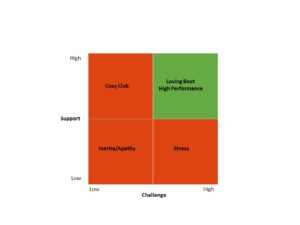 In the last post on Maturity and Courageous Conversations, I promised to write more about support vs challenge. Support is a crucial element of Courageously Responding.
In the last post on Maturity and Courageous Conversations, I promised to write more about support vs challenge. Support is a crucial element of Courageously Responding.
I’d argue that we can sometimes do too much of a good thing. You know, when a strength becomes a weakness. So support is good. And sometimes, it’s bad.
Not bad, exactly, but over-used or used at the wrong time. Sometimes we need to be more on the challenging end of the spectrum.
The same could be true the other way around – perhaps we over-challenge.
This is the model by Laurent Daloz, from his 1986 book ‘Effective Teaching and Mentoring.’ Quoted in Blakey, J and Day, I. (2012). ‘Challenging Coaching.’ London: Nicholas Brealey Publishing p19.
Support refers to interventions that affirm the value of the individual (building trust, respect, rapport) or those that reduce uncertainty & anxiety (encouragement, focusing on strengths, empathy).
Challenge refers to interventions that compel the individual to confront current reality (accountability, feedback, limiting beliefs) and to meet the changing expectations of all stakeholders (goal setting, visioning, alignment of values).
“A high level of challenge is not inherently “wrong.” In fact, its absence in a business environment leads to complacency, indulgence, apathy and disinterest. When the stakes are high, a lack of challenge causes people to ‘play small’ in an environment that is forever demanding they ‘step up.’ The key is for challenge to be provided alongside equally high levels of support. The support skills of coaching are used to create conditions in which a coachee feels secure enough to disclose private thoughts and feelings, and in turn to develop awareness. There must also be challenge to push this self-awareness further and move to sustainable self-development. Coaches have invested considerable time and effort in developing their supporting skills; the next step in the development of the profession is to bring challenging skills up to the same level of maturity and proficiency.”(p.18) This doesn’t only apply to coaches – it applies to us all as managers of people too.
Low challenge/low support – inertia and apathy. This environment is too dull, we become bored and disinterested and the “why bother?” question looms large, resulting in a lack of motivation to act.
High challenge/low support – produces stress. This is a scary place in which we get frightened, defensive and hostile.
Low challenge/high support – the “cosy club” which is too comfortable. In this zone there is high empathy, active listening and questioning, but also the risks we discussed earlier, including collusion.
High challenge/high support – is where growth and development can be maximized. This is the “loving boot” that can stimulate and “kick” a person to pursue a new direction or goal and to achieve high performance. This quadrant represents the optimum balance of support and challenge where coaches can unlock the highest potential for both individual and organization.
So…which quadrant do you think you are in personally at work at the moment? How can you get more support or more challenge?
And which quadrant do you tend to use the most as a supervisor of people? What have you learned here that leads you to try something different in the way you support and challenge your people?
My thanks to Eve Turner, Accredited Master Executive Coach, APECS Accredited Exective Coach and Coach Supervisor, for her summary of the model, used above.
For more on Conversations, check out our series so far:
- The power dynamics of the supervisor/ee relationship
- Games that supervisees play to regain some power
- Games that supervisors play
- The antidote to power play? Supervisors, listen up
- The antidote to power-play: supervisees, it’s your turn
- Emotional maturity in the supervisor/supervisee relationship
- Maturity and Courageous Conversations




